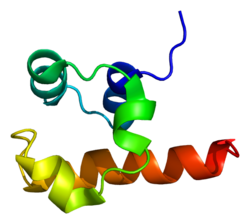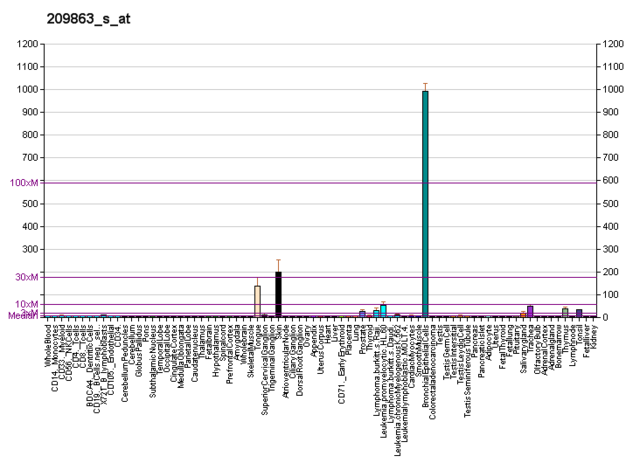p63,亦作TP63,全稱腫瘤蛋白p63(tumor protein p63)或惡性轉化相關蛋白63(transformation-related protein 63),在人體內由TP63基因編碼[6][7][8][9]。p63的發現是在p53基因發現後20年。p63與p53、p73同屬一個蛋白家族,三者結構與功能都較爲相似[10]。儘管p63的發現晚於p53,但進化生物學的證據表明p63是p53蛋白家族的起源,p53、p73都是由p63蛋白演化而成[11]。
事实速览 P63, 已知的結構 ...
| P63 |
|---|
 |
|
| 識別號 |
|---|
| 别名 | TP63;, AIS, B(p51A), B(p51B), EEC3, KET, LMS, NBP, OFC8, RHS, SHFM4, TP53CP, TP53L, TP73L, p40, p51, p53CP, p63, p73H, p73L, tumor protein p63 |
|---|
| 外部ID | OMIM:603273 MGI:1330810 HomoloGene:31189 GeneCards:TP63 |
|---|
|
| 相關疾病 |
|---|
| 肺腺癌、lymphoblastic leukemia、肺癌、ADULT綜合徵、附肢-乳腺綜合徵、AEC綜合徵、split hand-foot malformation 2[1] |
|
|
| RNA表达模式 |
|---|


 |
| 查阅更多表达数据 |
|
| 直系同源 |
|---|
| 物種 | 人類 | 小鼠 |
|---|
| Entrez | | |
|---|
| Ensembl | | |
|---|
| UniProt | | |
|---|
| mRNA序列 | | |
|---|
| 蛋白序列 | | |
|---|
| 基因位置(UCSC) | Chr 3: 189.63 – 189.9 Mb | Chr 16: 25.5 – 25.71 Mb |
|---|
| PubMed查找 | [4] | [5] |
|---|
| 維基數據 |
|
关闭
p63是p53蛋白家族下的一種轉錄因子。p63-/-基因型的小鼠會出現無牙、乳腺等發育依賴間充質-上皮相互作用的器官組織及無附肢等多種發育缺陷。p63蛋白的轉錄變體主要有兩種,TAp63和ΔNp63。已證明ΔNp63擁有多種功能,包括參與皮膚發育和成體幹細胞/祖細胞的功能調控[12]。相比之下,傳統的觀點認爲TAp63的功能幾乎只侷限於參與凋亡過程。不過,近期的研究還表明TAp63參與了卵母細胞完整性的維持[13]。另一些研究還表明TAp63參與了心臟發育[14]和早衰過程[15]。
p63蛋白的突變可能會導致兔脣、腭裂等發育畸形[16]。p63蛋白的突變可導致以等裂兔脣爲典型特徵的EEC綜合徵(ectrodactyly-ectodermal dysplasia-cleft syndrom)[16]。此外,p63蛋白的突變也可能導致3型兔脣腭裂綜合徵(EEC3)、先天性缺指(ectrodactyly,亦稱爲裂手-腳畸形4),以及以等裂兔脣爲典型特徵的AEC綜合徵[16]。此外,ADULT綜合徵(Acro–dermato–ungual–lacrimal–tooth syndrome)、附肢-乳腺綜合徵(limb-mammary syndrome)、RHS綜合徵(Rap-Hodgkin syndrome)以及也與p63蛋白功能的異常有關。目前認爲兔脣、腭裂是同時出現還是任出現一種取決於p63的不同突變[16]近期,研究人員提出使用iPS細胞分化替代缺陷型上皮細胞治療EEC綜合徵的方法[17]。
p63的免疫組化法可以用於診斷扁平細胞癌和前列腺腺癌(最常見的一種前列腺癌)[18]。正常的前列腺腺體含有基底細胞,因而組織高表達p63,免疫染色深,而惡性轉化後的腺癌組織因缺少基底細胞,p63免疫染色呈現陰性結果[19]。p63亦可用於鑑別腺癌、小細胞癌中常見的分化程度低的癌變扁平細胞[20]。
p63可與HNRPAB蛋白發生相互作用[21]。同樣,p63可以通過與轉錄因子IRF6增強子結合激活其轉錄[16]。
研究表明p63的表達受miRNAmiR-203的調控[22][23]。
Yang A, Kaghad M, Wang Y, Gillett E, Fleming MD, Dötsch V, Andrews NC, Caput D, McKeon F. p63, a p53 homolog at 3q27-29, encodes multiple products with transactivating, death-inducing, and dominant-negative activities. Molecular Cell. Sep 1998, 2 (3): 305–16. PMID 9774969. doi:10.1016/S1097-2765(00)80275-0. Osada M, Ohba M, Kawahara C, Ishioka C, Kanamaru R, Katoh I, Ikawa Y, Nimura Y, Nakagawara A, Obinata M, Ikawa S. Cloning and functional analysis of human p51, which structurally and functionally resembles p53. Nature Medicine. Jul 1998, 4 (7): 839–43. PMID 9662378. doi:10.1038/nm0798-839. Tan M, Bian J, Guan K, Sun Y. p53CP is p51/p63, the third member of the p53 gene family: partial purification and characterization. Carcinogenesis. Feb 2001, 22 (2): 295–300. PMID 11181451. doi:10.1093/carcin/22.2.295. Wu G, Nomoto S, Hoque MO, Dracheva T, Osada M, Lee CC, Dong SM, Guo Z, Benoit N, Cohen Y, Rechthand P, Califano J, Moon CS, Ratovitski E, Jen J, Sidransky D, Trink B. DeltaNp63alpha and TAp63alpha regulate transcription of genes with distinct biological functions in cancer and development. Cancer Research. May 2003, 63 (10): 2351–7. PMID 12750249. Skipper M. Dedicated protection for the female germline. Nature Reviews Molecular Cell Biology. January 2007, 8 (1): 4–5. doi:10.1038/nrm2091. Deutsch GB, Zielonka EM, Coutandin D, Weber TA, Schäfer B, Hannewald J, Luh LM, Durst FG, Ibrahim M, Hoffmann J, Niesen FH, Sentürk A, Kunkel H, Brutschy B, Schleiff E, Knapp S, Acker-Palmer A, Grez M, McKeon F, Dötsch V. DNA damage in oocytes induces a switch of the quality control factor TAp63α from dimer to tetramer. Cell. Feb 2011, 144 (4): 566–76. PMC 3087504  . PMID 21335238. doi:10.1016/j.cell.2011.01.013.
. PMID 21335238. doi:10.1016/j.cell.2011.01.013. Rouleau M, Medawar A, Hamon L, Shivtiel S, Wolchinsky Z, Zhou H, De Rosa L, Candi E, de la Forest Divonne S, Mikkola ML, van Bokhoven H, Missero C, Melino G, Pucéat M, Aberdam D. TAp63 is important for cardiac differentiation of embryonic stem cells and heart development. Stem Cells. Nov 2011, 29 (11): 1672–83 [2017-11-13]. PMID 21898690. doi:10.1002/stem.723. (原始内容存档于2014-08-08). Su X, Paris M, Gi YJ, Tsai KY, Cho MS, Lin YL, Biernaskie JA, Sinha S, Prives C, Pevny LH, Miller FD, Flores ER. TAp63 prevents premature aging by promoting adult stem cell maintenance. Cell Stem Cell. Jul 2009, 5 (1): 64–75. PMC 3418222  . PMID 19570515. doi:10.1016/j.stem.2009.04.003.
. PMID 19570515. doi:10.1016/j.stem.2009.04.003. Shalom Feuerstein R. et al. Impaired epithelial differentiation of induced pluripotent stem cells from EEC patients is rescued by APR-246/PRIMA-1MET. P.N.A.S 2012. 存档副本. [2014-12-13]. (原始内容存档于2014-12-14). Shiran MS, Tan GC, Sabariah AR, Rampal L, Phang KS. p63 as a complimentary basal cell specific marker to high molecular weight-cytokeratin in distinguishing prostatic carcinoma from benign prostatic lesions. The Medical Journal of Malaysia. Mar 2007, 62 (1): 36–9. PMID 17682568. Zhang H, Liu J, Cagle PT, Allen TC, Laga AC, Zander DS. Distinction of pulmonary small cell carcinoma from poorly differentiated squamous cell carcinoma: an immunohistochemical approach. Modern Pathology. Jan 2005, 18 (1): 111–8. PMID 15309021. doi:10.1038/modpathol.3800251. Fomenkov A, Huang YP, Topaloglu O, Brechman A, Osada M, Fomenkova T, Yuriditsky E, Trink B, Sidransky D, Ratovitski E. P63 alpha mutations lead to aberrant splicing of keratinocyte growth factor receptor in the Hay-Wells syndrome. The Journal of Biological Chemistry. Jun 2003, 278 (26): 23906–14. PMID 12692135. doi:10.1074/jbc.M300746200.
- Little NA, Jochemsen AG. p63. The International Journal of Biochemistry & Cell Biology. Jan 2002, 34 (1): 6–9. PMID 11733180. doi:10.1016/S1357-2725(01)00086-3.
- van Bokhoven H, McKeon F. Mutations in the p53 homolog p63: allele-specific developmental syndromes in humans. Trends in Molecular Medicine. Mar 2002, 8 (3): 133–9. PMID 11879774. doi:10.1016/S1471-4914(01)02260-2.
- van Bokhoven H, Brunner HG. Splitting p63. American Journal of Human Genetics. Jul 2002, 71 (1): 1–13. PMC 384966
 . PMID 12037717. doi:10.1086/341450.
. PMID 12037717. doi:10.1086/341450.
- Brunner HG, Hamel BC, van Bokhoven H. P63 gene mutations and human developmental syndromes. American Journal of Medical Genetics. Oct 2002, 112 (3): 284–90. PMID 12357472. doi:10.1002/ajmg.10778.
- Jacobs WB, Walsh GS, Miller FD. Neuronal survival and p73/p63/p53: a family affair. The Neuroscientist. Oct 2004, 10 (5): 443–55. PMID 15359011. doi:10.1177/1073858404263456.
- Zusman I. The soluble p51 protein in cancer diagnosis, prevention and therapy. In Vivo. 2005, 19 (3): 591–8. PMID 15875781.
- Morasso MI, Radoja N. Dlx genes, p63, and ectodermal dysplasias. Birth Defects Research. Part C, Embryo Today. Sep 2005, 75 (3): 163–71. PMC 1317295
 . PMID 16187309. doi:10.1002/bdrc.20047.
. PMID 16187309. doi:10.1002/bdrc.20047.
- Barbieri CE, Pietenpol JA. p63 and epithelial biology. Experimental Cell Research. Apr 2006, 312 (6): 695–706. PMID 16406339. doi:10.1016/j.yexcr.2005.11.028.
- Shalom-Feuerstein R, Lena AM, Zhou H, De La Forest Divonne S, Van Bokhoven H, Candi E, Melino G, Aberdam D. ΔNp63 is an ectodermal gatekeeper of epidermal morphogenesis. Cell Death and Differentiation. May 2011, 18 (5): 887–96. PMC 3131930
 . PMID 21127502. doi:10.1038/cdd.2010.159.
. PMID 21127502. doi:10.1038/cdd.2010.159.